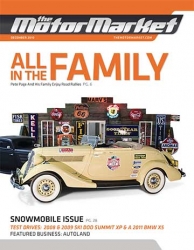
More Issues
- August 2023
- July 2023
- June 2023
- May 2023
- April 2023
- March 2023
- February 2023
- January 2023
- December 2022
- November 2022
- October 2022
- September 2022
- August 2022
- July 2022
- June 2022
- May 2022
- April 2022
- March 2022
- February 2022
- January 2022
- December 2021
- November 2021
- October 2021
- September 2021
- August 2021
- July 2021
- June 2021
- May 2021
- April 2021
- March 2021
- February 2021
- January 2021
- December 2020
- November 2020
- October 2020
- September 2020
- August 2020
- July 2020
- May 2020
- April 2020
- March 2020
- February 2020
- January 2020
- December 2019
- November 2019
- October 2019
- September 2019
- August 2019
- July 2019
- June 2019
- May 2019
- April 2019
- March 2019
- February 2019
- January 2019
- December 2018
- November 2018
- October 2018
- September 2018
- August 2018
- July 2018
- June 2018
- May 2018
- April 2018
- March 2018
- February 2018
- January 2018
- August 2011
What Drives You…4x4 Drives are Not Created Equal
You may have heard the terms Four-Wheel Drive, All-Wheel Drive, Part-Time Four-Wheel Drive, and Full-Time Four-Wheel Drive, or any other number of combinations used when considering the purchase of a vehicle or already own one. What do they all mean? Is one easier to maintain than the other? And which one may be right for you? All of these are regular questions asked of us at Under The Hood®.
Types of 4-Wheel Drive 1. All-Wheel Drive. This type of drive provides power to the front and rear wheels all of the time and incorporates some type of a mechanical or electrical system to equally split the power between the front and rear wheels. There is no driver input required or available in most systems and it is commonly found in cars and mini-vans. To use this system the driver needs to do nothing but drive the vehicle and the system will automatically provide the best traction available. This system is great for the average daily driver who wants the best traction in all conditions without driver interaction. Maintenance is usually limited to changing oil on a transfer case at recommended intervals and greasing propeller shafts if available.
2. Part-Time 4-Wheel Drive. Found primarily on light trucks and SUVs this type of system is just like it sounds, part time. It is switched on by the driver in times of low traction by means of a dash mounted switch or floor lever. Some vehicles have dials to turn on the front axle hubs as well that must be turned in order to activate the connection to the front wheels while others have fully automatic hubs. In most cases the driver can also command a low and high range for heavy duty situations. When traction is not low it must be turned off to prevent premature wear or damage to the system. Maintenance on these systems consists of front and rear differential service, transfer case service, shaft grease and occasionally putting the system into 4-wheel drive to keep it free.
3. Full-Time 4-Wheel Drive. This system found primarily on light trucks and SUVs also provides full time power to all wheels like All-Wheel Drive but is heavier duty and usually provides the option of a low range position. It too is running at all times and requires no driver input other than changing to low range if needed which most of us will never use in routine daily driving. Just like All- Wheel Drive, this system is great for the average daily driver who wants the best traction in all conditions without driver interaction. Maintenance is similar to Part-Time 4-Wheel Drive without having to engage it on occasion.
Maintenance All systems need some sort of maintenance now and then to keep the failures to a minimum. Your owner’s manual is a great resource for what your individual vehicle needs. It is important to follow it and consult with your own mechanic on what they feel should be done in your area due to weather conditions and their experience on other models like yours. What is normal service in Florida is not normal service in South Dakota. We see a variety of 4-Wheel Drive failures year round at Nordstrom’s right here in South Dakota, but there is one most common failure to all 4-wheel drive systems that have a button or dial on the dash to control them. Every week I answer at least a couple of emails or field phone calls about failed 4-Wheel Drive that could have been prevented for a cost of absolutely nothing and takes only seconds to perform by the driver. The electric motor that activates the system will fail when not used. On systems with push button or dial 4-Wheel Drive they should be activated throughout their range a couple times a month to keep them healthy. By turning them on for a few seconds the electric motor gets to “stretch its legs” so to speak and the lubricated parts get lubrication. Just like a person, inactivity causes failure that can be prevented.
Tune in each week to Under The Hood® Radio show on a station near you and visit www.underthehoodshow.com if you have a question about your vehicle, we want to hear about it.
